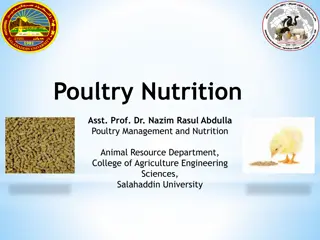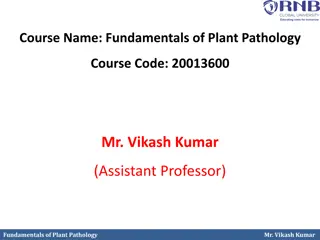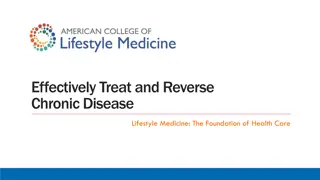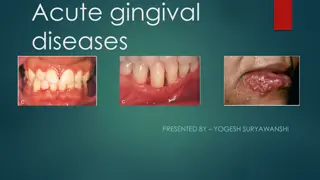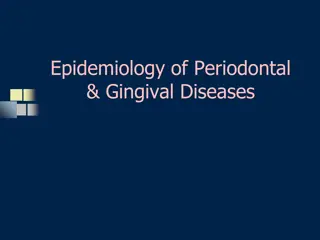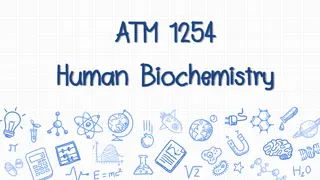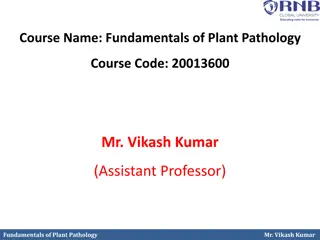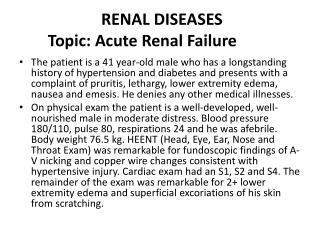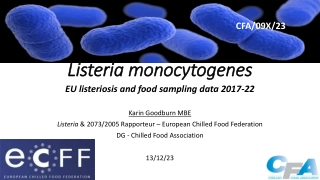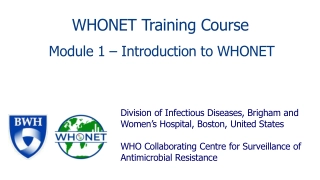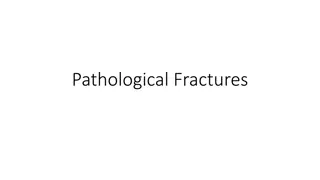Introduction to Poultry Diseases
Explore causes of diseases in the poultry industry, including infections, environmental stresses, and nutritional deficiencies. Learn how these factors affect bird health and productivity.
Download Presentation
Please find below an Image/Link to download the presentation.
The content on the website is provided AS IS for your information and personal use only. It may not be sold, licensed, or shared on other websites without obtaining consent from the author. Download presentation by click this link. If you encounter any issues during the download, it is possible that the publisher has removed the file from their server.
Presentation Transcript
poultry diseases 1 fourth stage chapter one lecture 1 Introduction to Poultry Diseases Dr.Harith Abdulla Department of Pathology and Poultry Disease College of Veterinary Medicine University of Basrah University of Basrah- College of veterinary medicine- Department of Pathology and Poultry Disease
WHAT IS A DISEASE? In common terms, a disease is an abnormal condition that is caused by infection, basic weaknesses, or environmental stress. A disease is defined by a specific group of signs or symptoms.
This can result in poor productivity and reduced quality of the affected animals. It could even lead to the death/loss of one or all of the birds in a flock.
Infectious agents Infectious diseases are caused by viruses, bacteria, and fungi. Parasitic diseases are caused by protozoa, worms, and external parasites such as mites and lice.
Environmental stress Temperature stress Heat and cold Environmental stress Air, light and litter Physiological stress Production and reproduction Social stress Housing Physical stress Handling
Now in general what is your opinion about causes of disease in poultry industry. WHICH ONE IS MORE IMPORTANT
Poultry Diseases 1-Metabolic and Nutrional Deficiency Diseases. 2-Bacterial and Mycoplasmal Diseases. 3-Fungal Diseases. 4-Parasitic Diseases. A-Protozoal Diseases. B-Endoparasite (Internal). C-Ectoparasite( External). 6-Viral Diseases.
Nutritional Deficiency Diseases Nutritional deficiency diseases, also known as malnutrition or under nutrition, occur when an individual's diet lacks essential nutrients or when their body is unable to absorb and utilize these nutrients properly. These conditions can have serious health consequences and may lead to a range of specific diseases and disorders.
Vitamins The amounts of various vitamins needed in poultry diets are very low. The vitamins function as cofactors for enzymes, hormones (e.g., vitamins A, D), or antioxidants (previtamin A and vitamin E). The fat-soluble vitamins A, D, and E are stored relatively well and birds can withstand long periods of depletion before deficiency symptoms manifest. Water-soluble vitamins are not stored to a large extent, excesses are excreted mostly in urine, and they are relatively nontoxic.
Vitamin A Is required for the health of the membranes of the digestive, urinary, reproductive and respiratory systems. A vitamin A deficiency can result when the level in the diet is inadequate or the vitamin added to the diet is oxidized by rancid fat in the diet. Additionally, neomycin, a common antibiotic, decreases the absorption of vitamin A. Vitamin A is a fat-soluble vitamin and an inadequate level of fat in the diet could also limit its absorption, even if in the diet at adequate levels.
Vitamin A Deficiency Vitamin A deficiency in the embryo results in a grossly abnormal cardiovascular system, characterized by an absence of vascular networks. In chickens and turkeys (insufficient vitamin A during 1-7 weeks of age). As in the case of other nutritional deficiencies, classic signs of deficiency are very rare in commercial poultry fed complete diets.
Functions of vitamin A : Vitamin A is essential in poultry rations for: a- Growth. b-Optimum vision. c-Maintaining the integrity of the mucous membrane. General Signs 1-Poor growth. 2-Poor feathering. 3-Drowsiness. 4.Off food. 5-Pale comb and wattles. 6- Rough feathers.
Special Signs of Vitamin A Deficiency: 1-Watery nasal and ocular discharge. 2-Eyelids stuck together with thick milky exudates. 3-Decrease egg production. 4-Increase embryonic mortality. 5-Ataxia. 6-Xerophthalmia. 7-Caseous material under the eyelids.
Post_mortem lesions: Because epithelial linings of alimentary, urinary, genital, and respiratory systems are composed of mucous membranes, these are the tissues in which lesions of vitamin A deficiency are most readily observed as: 1-Eyelids inflamed and adhered. 2-Excessive urates in kidneys and ureters. 3-Pustules in mouth and pharynx. 4-Enlarged gall bladder. 5-Small ulcers at the site of the lesions.
Histopathology : 1-Atrophy of cytoplasm and loss of cilia in the columnar ciliated epithelium of the respiratory tract . 2-Respiratory epithelium transformed into stratified squamous keratinized epithelium. Diagnosis: 1- Feed formulation. 2-Signs. 3-Lesions. 4-Histopathology.
Differential diagnosis: 1-Infectious coryza. 2-Chronic fowl cholera. 3-Infectious sinusitis. 4-Avian pox. 5-Trichomoniasis. 6-Thrush. Prevention: Supplementation of diet with vitamin A. Treatment: vitamin A in drinking water




